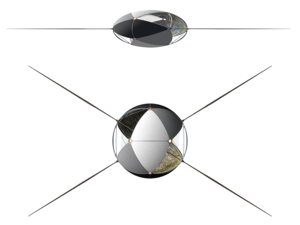Christian Waldvogel
|
Globus Cassus is an art project and book by Swiss architect and artist Christian Waldvogel presenting a conceptual transformation of Planet Earth into a much bigger, hollow, artificial world with an ecosphere on its inner surface. It was the Swiss contribution to the 2004 Venice Architecture Biennale and was awarded the Gold Medal in the category "Most beautiful books of the World" at the Leipzig Book Fair in 2005. It consists of a meticulous description of the transformation process, a narrative of its construction, and suggestions on the organizational workings on Globus Cassus.
The proposed megastructure would incorporate all of Earth's matter. Sunlight would enter through two large windows, and gravity would be simulated by the centrifugal effect. Humans would live on two vast regions that face each other and that are connected through the empty center. The hydrosphere and atmosphere would be retained on its inside. The ecosphere would be restricted to the equatorial zones, while at the low-gravity tropic zones a thin atmosphere would allow only for plantations. The polar regions would have neither gravity nor atmosphere and would therefore be used for storage of raw materials and microgravity production processes.
Globus Cassus has the form of a compressed geodesic icosahedron with two diagonal openings. Along the edges of the icosahedron run the skeleton beams, the gaps between the beams contain a shell and, where there are windows, inward-curving domes.
Earth's crust, mantle and core are gradually excavated, transported outwards and then transformed to larger strength and reduced density. While the crust is mined from open pits in the continent's centers, magma and the liquid mantle are pumped across transfer hoses. The core is dismantled from the surface.
...
Wikipedia

